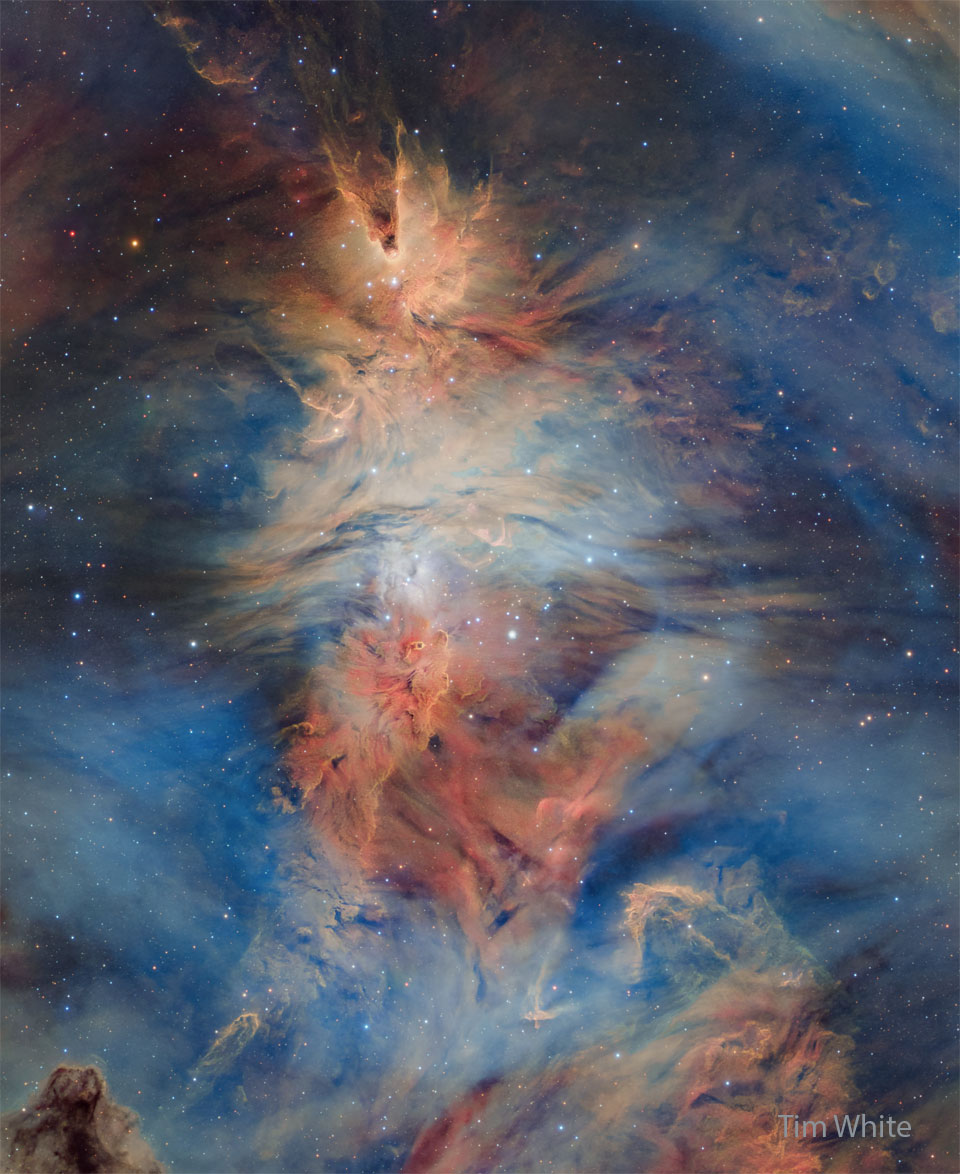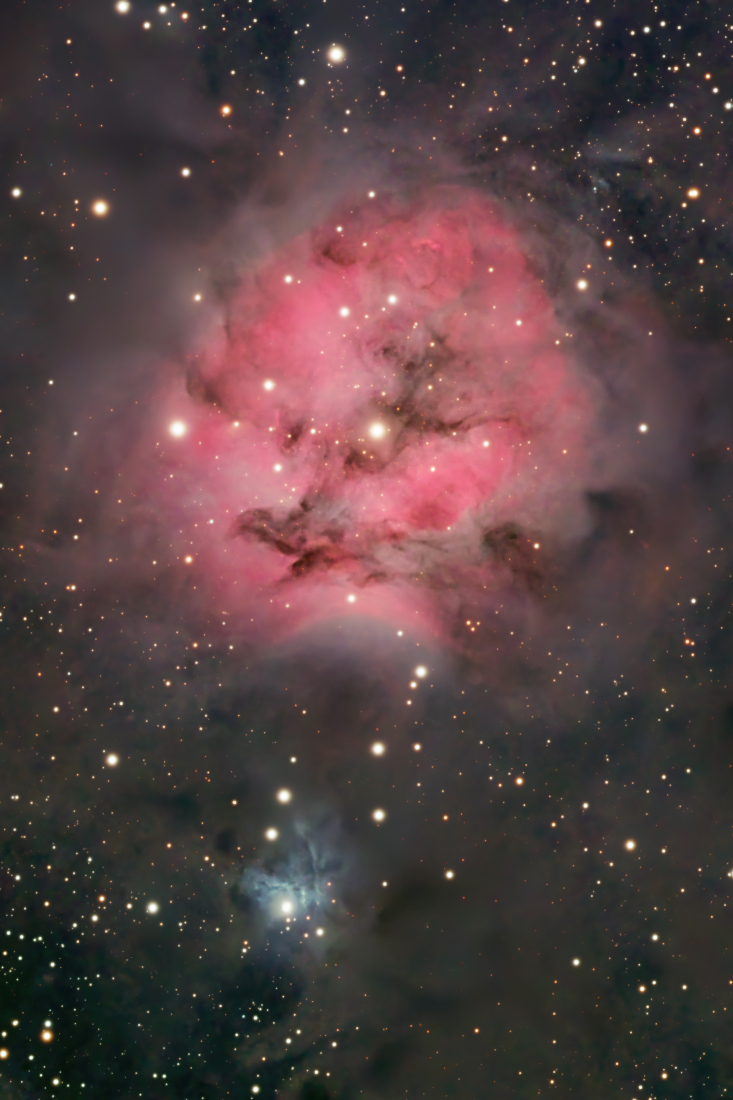Nombre total de pages vues
29/08/2022
MACROPHOTOGRAPHIE - Trois gouttelettes de rosée
ASTRONOMY - The Horsehead Nebula Region without Stars
2022 August 29
Image Credit & Copyright: George Chatzifrantzis
Explanation: The famous Horsehead Nebula in Orion is not alone. A deep exposure shows that the dark familiar shaped indentation, visible just right of center, is part of a vast complex of absorbing dust and glowing gas. The featured spectacular picture details an intricate tapestry of gaseous wisps and dust-laden filaments that were created and sculpted over eons by stellar winds and ancient supernovas. The Flame Nebula is visible in orange just to the Horsehead's left. To highlight the dust and gas, most of the stars have been digitally removed, although a notable exception is Alnitak, just above the Flame Nebula, which is the rightmost star in Orion's famous belt of three aligned stars. The Horsehead Nebula lies 1,500 light years distant towards the constellation of Orion.
28/08/2022
ASTRONOMY - Perijove 11: Passing Jupiter
2022 August 28
Video Credit: License: NASA, Juno, SwRI, MSSS, Gerald Eichstadt; Music: Moonlight Sonata (Ludwig van Beethoven)
Explanation: Here comes Jupiter! NASA's robotic spacecraft Juno is continuing on its highly-elongated orbits around our Solar System's largest planet. The featured video is from perijove 11 in early 2018, the eleventh time Juno has passed near Jupiter since it arrived in mid-2016. This time-lapse, color-enhanced movie covers about four hours and morphs between 36 JunoCam images. The video begins with Jupiter rising as Juno approaches from the north. As Juno reaches its closest view -- from about 3,500 kilometers over Jupiter's cloud tops -- the spacecraft captures the great planet in tremendous detail. Juno passes light zones and dark belt of clouds that circle the planet, as well as numerous swirling circular storms, many of which are larger than hurricanes on Earth. After the perijove, Jupiter recedes into the distance, then displaying the unusual clouds that appear over Jupiter's south. To get desired science data, Juno swoops so close to Jupiter that its instruments are exposed to very high levels of radiation.
27/08/2022
ASTRONOMY - IC 5146: The Cocoon Nebula
2022 August 27
Image Credit & Copyright: David Jenkins
Explanation: Inside the Cocoon Nebula is a newly developing cluster of stars. Cataloged as IC 5146, the beautiful nebula is nearly 15 light-years wide. Climbing high in northern summer night skies, it's located some 4,000 light years away toward the constellation Cygnus the Swan. Like other star forming regions, it stands out in red, glowing, hydrogen gas excited by young, hot stars, and dust-reflected starlight at the edge of an otherwise invisible molecular cloud. In fact, the bright star found near the center of this nebula is likely only a few hundred thousand years old, powering the nebular glow as it clears out a cavity in the molecular cloud's star forming dust and gas. A 29 hour long integration with a small telescope from Ayr, Ontario, Canada resulted in this exceptionally deep color view tracing tantalizing features within and surrounding the dusty stellar nursery.
26/08/2022
MERVEILLEUX MONDE SOUS-MARIN - La gorgone rouge et le gorgonocéphale
ASTRONOMY - Little Planet South Pole
2022 August 26
Image Credit & Copyright: Aman Chokshi
Explanation: Lights play around the horizon of this snowy little planet as it drifts through a starry night sky. Of course the little planet is actually planet Earth. Recorded on August 21, the digitally warped, nadir centered panorama covers nearly 360x180 degrees outside the Amundsen-Scott South Pole Station, Antarctica. The southernmost research outpost is near the horizon at the top where the light of dawn is approaching after nearly six months of darkness. Along the bottom is the ceremonial pole marker surrounded by the 12 flags of the original signatories of the Antarctic treaty, with a wild display of the aurora australis above.
25/08/2022
ASTRONOMY - Tiangong Space Station Transits the Moon
2022 August 25
Image Credit & Copyright: Lucy Yunxi Hu
Explanation: The rugged lunar south polar region lies at the top of this colorful portrait of a last quarter Moon made on August 20. Constructed from video frames and still images taken at Springrange, New South Wales, Australia it also captures a transit of China's Tiangong Space Station. The transit itself was fleeting, taking the space station less than a second to cross the shadowed and sunlit lunar disk. The low Earth orbiting Tiangong is at an altitude of about 400 kilometers, while the Moon is some 400,000 kilometers away. Subtle color differences along the bright lunar surface are revealed in the multiple stacked frames. Not visible to the eye, they indicate real differences in chemical makeup across the lunar surface.
24/08/2022
ASTRONOMY - The Cartwheel Galaxy from Webb
2022 August 24
Image Credit: NASA, ESA, CSA, STScI, Webb ERO Production Team
Explanation: To some, it looks like a wheel of a cart. In fact, because of its outward appearance, the presence of a central galaxy, and its connection with what looks like the spokes of a wheel, the galaxy on the right is known as the Cartwheel Galaxy. To others, however, it looks like a complicated interaction between galaxies awaiting explanation. Along with the two galaxies on the left, the Cartwheel is part of a group of galaxies about 500 million light years away in the constellation Sculptor. The large galaxy's rim spans over 100,000 light years and is composed of star forming regions filled with extremely bright and massive stars. The Cartwheel's ring-like shape is the result of gravitational disruption caused by a smaller galaxy passing through a large one, compressing the interstellar gas and dust and causing a star formation wave to move out like a ripple across the surface of a pond. The featured recent image of the Cartwheel Galaxy by the Webb Space Telescope reveals new details not only about where stars are forming, but also about activity near the galaxy's central black hole.
23/08/2022
ASTRONOMY - Meteor & Milky Way over the Mediterranean
2022 August 23
Image Credit & Copyright: Julien Looten
Explanation: Careful planning made this a nightscape to remember. First, the night itself was chosen to occur during the beginning of this year's Perseid Meteor Shower. Next, the time of night was chosen to be before the bright Moon would rise and dominate the night sky's brightness. The picturesque foreground was selected to be a rocky beach of the Mediterranean Sea in Le Dramont, France, with, at the time, île d’Or island situated near the ominously descending central band of our Milky Way Galaxy. Once everything was set and with the weather cooperating, all of the frames for this seemingly surreal nightscape were acquired within 15 minutes. What you can't see is that, on this night, the astrophotographer brought along his father who, although unskilled in modern sky-capture techniques, once made it a point to teach his child about the sky.
22/08/2022
MERVEILLEUX MONDE SOUS-MARIN - Poissons-clowns de Clark dans leur anémone
ASTRONOMY - Fox Fur, Cone, and Christmas Tree
2024 December 24 Fox Fur, Cone, and Christmas Tree Image Credit & Copyright: Tim White Explanation: What do the following things have...

-
2021 May 11 Lightning and Orion Beyond Uluru Image Credit & Copyright: Park Liu Explanation: What's happening behind Uluru? A Un...
-
Extraordinary Solar Halos Image Credit & Copyright : Magnus Edback Explanation: Welcome to the December Solstice, the first...








